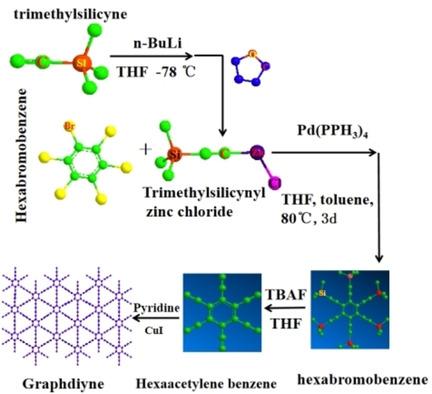当前位置:
X-MOL 学术
›
ChemCatChem
›
论文详情
Our official English website, www.x-mol.net, welcomes your
feedback! (Note: you will need to create a separate account there.)
Distinctive Improved Synthesis and Application Extensions Graphdiyne for Efficient Photocatalytic Hydrogen Evolution
ChemCatChem ( IF 3.8 ) Pub Date : 2020-02-07 , DOI: 10.1002/cctc.201902405 Yanbing Li 1 , Hao Yang 1 , Guorong Wang 1 , Bingzhen Ma 1 , Zhiliang Jin 1
ChemCatChem ( IF 3.8 ) Pub Date : 2020-02-07 , DOI: 10.1002/cctc.201902405 Yanbing Li 1 , Hao Yang 1 , Guorong Wang 1 , Bingzhen Ma 1 , Zhiliang Jin 1
Affiliation

|
Graphdiyne (GD), a novel two‐dimension carbon hybrid material, due to its unique and excellent properties, has been widely concerned since this innovative material was successfully synthesized by Prof. Yuliang Li in 2010. Traditionally, its synthesis method is growing graphdiyne on copper foils or foam copper as a base catalytic material to deliver copper ions (Cu2+) under pyridine conditions. Here, an innovative progress for graphdiyne preparation approach of using Cu+ ion as a catalytic material is reported and its application in extending to the photocatalytic water‐splitting to produce hydrogen in situ as well. In detail, by means of cuprous iodide used as a catalyst‐carrier to grow a graphdiyne in a pyridine solution of monomeric hexynylbenzene and such CuI‐graphdiyne composite catalyst is directly applied to photocatalytic hydrogen production in situ. Meanwhile, the hydrogen production of GD and CuI are 29.42 μmol/5 h and 156.49 μmol/5 h, respectively. In particular, the composite catalyst GD‐CuI exhibits an optimum photo‐catalytic hydrogen production activity (465.95 μmol/5 h) which is 15.8 times and 3.0 times that of pure GD and CuI respectively. This rational design, one‐step construction of GD‐CuI, successfully enhances photo‐catalytic hydrogen evolution activity. The deeper characterization study results such as TEM, SEM, XPS, XRD, UV‐vis DRS, Transient photocurrent and FT‐IR etc. have been well researched and the results of which are in good agreement with each other.
中文翻译:

高效光催化制氢的独特改进合成方法和应用扩展石墨二炔
Graphdiyne(GD)是一种新颖的二维碳杂化材料,由于其独特而优异的性能,自从李玉良教授于2010年成功合成该创新材料以来,备受关注。传统上,其合成方法是在铜箔或泡沫铜作为基本催化材料,可在吡啶条件下传递铜离子(Cu 2+)。在这里,使用Cu +的石墨二炔制备方法的创新进展离子作为催化材料已经报道,其在扩展到光催化水分解中也可用于原位产生氢。详细地讲,通过使用碘化亚铜作为催化剂载体在单体己炔苯的吡啶溶液中生长石墨二炔,并将这种CuI-石墨二炔复合催化剂直接用于原位光催化制氢。同时,GD和CuI的制氢量分别为29.42μmol/ 5 h和156.49μmol/ 5 h。特别是,复合催化剂GD-CuI表现出最佳的光催化制氢活性(465.95μmol/ 5 h),分别是纯GD和CuI的15.8倍和3.0倍。这种合理的设计,即GD-CuI的一步构建,成功地增强了光催化制氢的活性。
更新日期:2020-02-07
中文翻译:

高效光催化制氢的独特改进合成方法和应用扩展石墨二炔
Graphdiyne(GD)是一种新颖的二维碳杂化材料,由于其独特而优异的性能,自从李玉良教授于2010年成功合成该创新材料以来,备受关注。传统上,其合成方法是在铜箔或泡沫铜作为基本催化材料,可在吡啶条件下传递铜离子(Cu 2+)。在这里,使用Cu +的石墨二炔制备方法的创新进展离子作为催化材料已经报道,其在扩展到光催化水分解中也可用于原位产生氢。详细地讲,通过使用碘化亚铜作为催化剂载体在单体己炔苯的吡啶溶液中生长石墨二炔,并将这种CuI-石墨二炔复合催化剂直接用于原位光催化制氢。同时,GD和CuI的制氢量分别为29.42μmol/ 5 h和156.49μmol/ 5 h。特别是,复合催化剂GD-CuI表现出最佳的光催化制氢活性(465.95μmol/ 5 h),分别是纯GD和CuI的15.8倍和3.0倍。这种合理的设计,即GD-CuI的一步构建,成功地增强了光催化制氢的活性。































 京公网安备 11010802027423号
京公网安备 11010802027423号